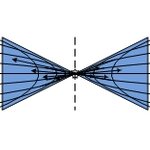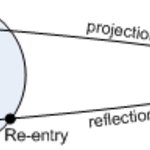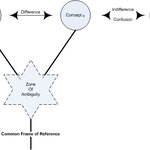Science Education & Policy

You might think that those who are skeptical (or downright intransigent) on a CO2 basis for global warming are bigger wasters of energy or greater polluters than those who accept climate science.
Not so. Skeptics are just as green. Their reasons may simply be different.
In 2008, Ed Maibach and colleagues did a survey (Who's 'Greener', Democrats Or Republicans?) and found that percentages of people concerned about our climate future to varying degrees were about what you would expect; on the fringes were outright deniers that pollution could be bad on one side and on the other…

1. Introduction 2: Patterns3: Patterns, Objectivity and Truth4: Patterns and Processes
The Pattern Library:
A pattern of Difference
2. A Pattern of Feedback
The Hourglass Pattern
This is a pattern that I like very much, because it is simple and yet very unusual. I call this the 'hourglass pattern' because of the shape, as you can see below.
Pattern
Hourglass
Description
interface, boundary, wall, gate,...
Notes
- The interface can demarcate ‘inside’ from ‘outside’, but also mediate, or be an intermediary between different domains, or…

Methodological Stuff:
1. Introduction 2: Patterns3: Patterns, Objectivity and Truth4: Patterns and Processes
The Pattern Library:
1. A pattern of Difference
The second pattern that will be introduced today is going to be quite familiar to many; it is feedback. The concept of feedback has a long history, but I would personally consider Harold Black to be the 'father' of our current understanding of this process. In the 1920's he discovered regenerative, or negative feedback, and this introduced a mechanism that largely contributes to the technological…
"Sir, if you were to suddenly appear in space would you be able to talk because you already had air in your lungs?"
This was a question shouted out by a year 8 pupil last week in the middle of a class discussion about breathing. How would you answer? Perhaps with "That isn't relevant to what we're learning about today, ask me again later"? Or would you take a huge detour and try to explain what sound is and how your body would react in space? The question itself was so unrelated to the topic we were discussing that it might give you cause to wonder whether the pupil had been paying any…

Methodological Stuff:
1. Introduction 2: Patterns3: Patterns, Objectivity and Truth4: Patterns and Processes
The Pattern Library:
1. A pattern of Difference
After all the conceptual geekery, it is time to move on to the practical sides of patterns. From the previous posts , it may come as a bit of a surprise that patterns aim are very simple to use, and often have a very intuitive application. This is not restricted to the patterns of PAC, but have been one of (and maybe the main) reason why design patterns became so popular in software engineering, and…

1. Introduction 2: Patterns3: Patterns, Objectivity and Truth4: Patterns and Processes
So far, PAChas been introduced as one epistemological system amongst others, has its ownfocus, (hopefully) strengths and weaknesses, and therefore acts like a lenswith its own focal point (s). Thisraises the question how PAC compares to other epistemological systems(theories, frameworks, schools of thought), and under the premise of limitedknowledge, they can only have their own specific strengths and weaknesses thatallows these systems to have their own focal points. With this, the whole issueof the…

Methodological Stuff:1. Introduction 2: Patterns3: Patterns, Objectivity and Truth4: Patterns and Processes
The Pattern Library:
A pattern of Difference
A Pattern of Feedback
So far, PAC has been introduced as one epistemological system amongst others, has its own focus, (hopefully) strengths and weaknesses, and therefore acts like a lens with its own focal point (s). This raises the question how PAC compares to other epistemological systems (theories, frameworks, schools of thought), and under the premise of limited knowledge, they can only have their own specific strengths and…

If we have done away -like postmodernism- with the notion of absolute truth, and we are living in a life-world where observers with limited knowledge try to 'make sense' of their envirnoment, then we we have certain freedom to define other forms of truth.
1. Introduction 2: Patterns3: Patterns, Objectivity and Truth
In a pattern-orientation, there is at least one sort of truth that we could think of, and that is when two patterns make an exact match. In other words, two patterns have an identical structure, and thus make a form that is exactly the same as the pattern. When a pattern that is…

In the first post I introduced a view on 'complexity thinking' which presupposes a life-world where ambiguity, uncertainty, indeterminacy and other hard to grasp concepts play an important role, both in a creative as in a destructive way.
1. Introduction 2: Patterns
This life-world also allows for the formation (organisation) of order, and a methodology of complexity should offer some assistance in the recognition of these orderly phenomena. PAC uses a pattern-orientation to 'make sense' of this life-world, and this sense is one of many other scientific methodologies that take this…
Dr. Paynter of the MD Dept of Ed noted that "all students have gifts, but there are some students who are ready, right now, to play varsity." In America, we easily accept that some kids are just more athletic than others, and we support that. In fact, we're pretty happy accepting that some kids are just naturals at art, math, acting, being charismatic, being beautiful, or doing sports.
But suggest some kids are more gifted at learning, and you get the retort "but all children are gifted." Ask for better learners to get special teaching and now, you're elitist.
Funny thing is…